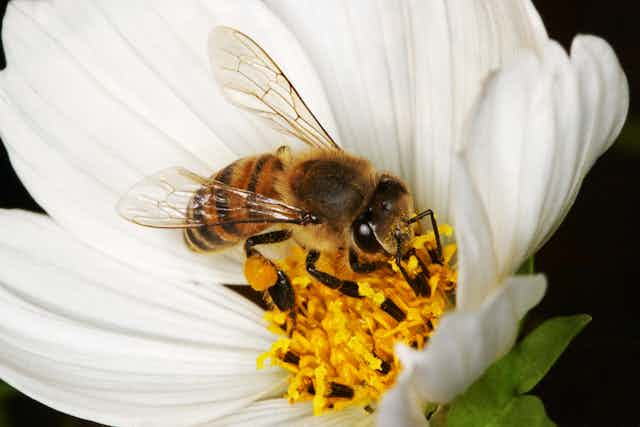The world is worried about honey bees. There are fears globally that bees may become extinct. This would have implications for food security: between 50% and 80% of the world’s food supply – fruits, vegetables and the seeds used to produce grain for livestock – is directly or indirectly affected by honey bee pollination.
Most studies suggest that nearly one-third of the world’s crops depend on honey bees for pollination. Others have shown that disruptions in pollination of various crops could have serious implications for public health, particularly in Africa and Asia. About 56% of populations in most developing countries would be at risk of nutrient deficiency if pollinators were wiped out.
Amid all the panic, little attention has been paid to the people and systems that make it possible to keep and manage pollinators – like beekeepers. And in particular, what beekeepers need to be able to meet the food needs of bees.
Previous research on bee forage – the nectar and pollen that bees get from plants – in South Africa concentrated on the Western Cape Province. For my research, I looked at bee forage in the country’s nine provinces. The Department of Agriculture estimates that there are 80 000 registered colonies managed by beekeepers in the country.
I set out to research what forage beekeepers in South Africa were relying on for their managed bees. I focused on the contribution that forage makes to honey production, pollination services, swarm trapping and colony maintenance. These form the core basis of most, if not all, beekeeping operations.
My results show that bees rely on a wide variety of both indigenous and exotic forage. But the use, importance, and availability of forage was not the same across the country’s provinces. This is a clear indication that beekeeping cannot depend on a single forage source which makes the business of ensuring bees have what they need to stay healthy a precarious business.
Keeping bees fed
In bee nutrition, nectar serves as a carbohydrate source and pollen provides protein. These are provided by a wide variety of plants and are essential for the bees’ diverse diet so their immune systems can function optimally. This keeps them healthy and productive.
There are two indigenous subspecies of Cape honey bee Apis mellifera capensis and African/Savannah honey bee Apis mellifera scutellata in South Africa. They differ in their geographical distribution and several other morphological and behavioural traits. But their nutritional requirements are the same.

There are a number of threats to meeting these requirements. One is that more and more of South Africa’s land is being used for agricultural purposes. This has cut into wild honey bees’ natural habitat and other insect pollinators, resulting in less to no pollination in some areas.
Another threat in some regions is the eradication of eucalyptus trees following a government decision to declare them an invasive species. This has particularly affected the South-Western Cape. The establishment of a forestry industry in the region towards the end of the 19th century provided good, reliable forage through various eucalyptus tree plantations. This contributed to the basis of current beekeeping.
Research shows that eucalyptus trees are essential to the beekeeping industry.
Indigenous and exotic
I was interested in finding out what plants beekeepers in all nine of the country’s provinces use for their beekeeping practices. I also wanted to know if these plants were valued equally for the respective practices. I found that a wide variety of indigenous and exotic plants are used in the different beekeeping practices.
For example, the Eastern and Northern Cape provinces have a heavy dependence on indigenous forage like bushveld aloes, trees and shrubs, fynbos and Karoo vegetation. Beekeepers in the other seven provinces relied mostly on exotics like eucalyptus species, agricultural crops, weeds and suburban plantings.
Different forage types were not contributing equally or used at the same level for each of the beekeeping practices and among provinces. This means that a species of importance in one province – like sugar gum in the Western Cape – would not have the same or similar impact in other provinces. This makes sense as plants and cropping systems differ among provinces due to climatic and soil conditions.
Also, the flowering period differs between plants and this dictates when the plant can be used and for how long. This makes it challenging for beekeepers to continue finding good forage for their bees. In most areas, beekeepers have to travel hundreds of kilometres in search of sites – and the hives have to be moved around when forage become less usable.
No forage, no bees, no pollination
The protection of honey bees, their natural habitats and forage, should take centre stage to ensure their health and well-being. But because forage use in each province is different, forage management must be tailored according to each province’s beekeeping needs. This might require a shift in policy and legislative tools – at an agricultural, environmental and economic level.
Policies need to protect honey bees and their forage, and also ensure that good bee forage is extensively planted.

